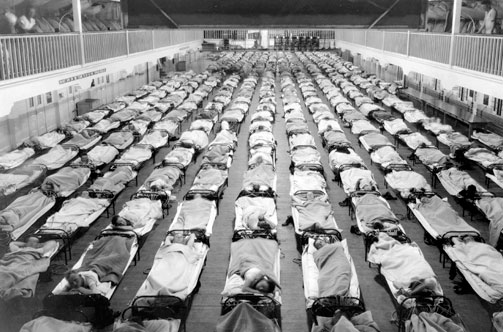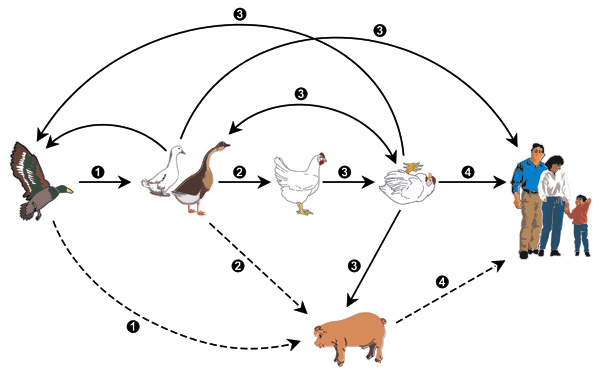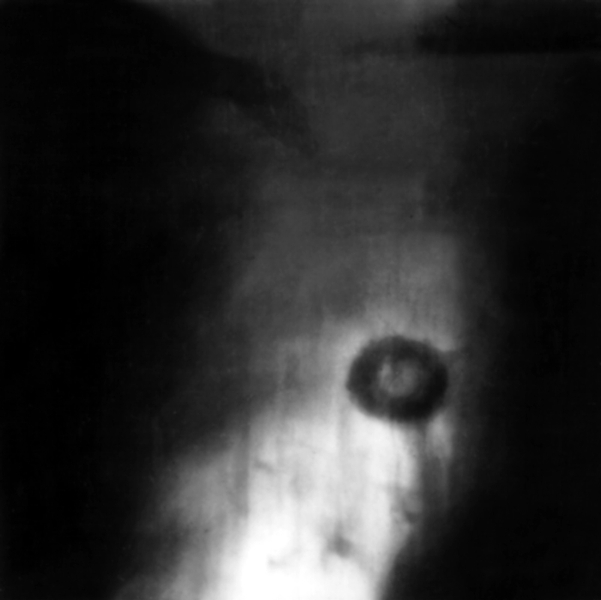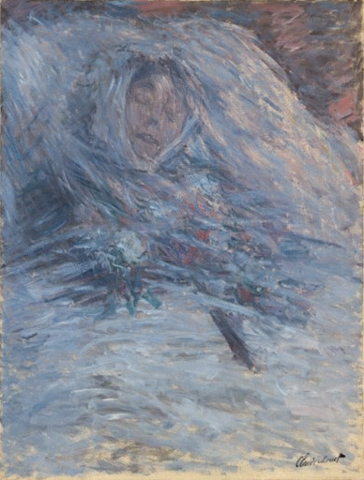The history of world epidemics, part 3
We talked about plague and smallpox , cholera and typhus . The next step is a viral infectious disease called influenza, one of the strains of which only in 1918-1919 killed more than 50 million people from an infected third of the world's population, and tuberculosis, because of which 2 million people even now die every year.

Pandemic "Spaniards" in the years 1918-1919.
Influenza is a viral disease, and viruses are very well able to mutate. In total, scientists have identified more than two thousand variants of the virus. Only in the last hundred years, several different strains have killed hundreds of thousands and even millions of people. Every year, half a million people die from epidemics.
People of any age are susceptible to influenza, but it can be most dangerous for children and elderly people. Most often the disease ends in death when the patient is over sixty-five years old. Epidemics begin mainly in the cold season, at temperatures from +5 to -5, when the humidity of the air decreases, which creates favorable conditions for the penetration of the virus into the human body through the respiratory tract.
')
After the incubation period, which lasts up to three days, the disease begins. When you feel irritation in your nose, trachea or bronchi during an illness, this means that the virus has entered the cells of the ciliated epithelium and is now destroying them. The person coughs, sneezes and blows his nose constantly. Then the virus enters the bloodstream and spreads throughout the body. The temperature rises, headaches and chills appear. After three to five days of illness, the patient recovers, but he remains tired. In severe forms, the flu can lead to brain swelling and various complications, including the development of bacterial infections.
The largest pandemic of the “Spanish flu” during the First World War claimed the lives of more than fifty million people, according to some estimates, up to one hundred million. It was a strain of H1N1, and it spread throughout the world. The name “Spaniard” was obtained only because of the epidemic, about which all the countries participating in the war were silent, began to speak only in neutral Spain.
The H1N1 virus was a mutated virus common among wild birds. This came from only two mutations in the hemagglutinin molecule, a surface protein of the influenza virus, which provides the ability of the virus to attach to the host cell.
In 1918, 39% of the country's population were infected with the flu in Spain, including people of twenty or forty years old, who are least at risk of catching the disease. People have chenille faces, developed pneumonia. Patients were coughing up blood that could be choked in the later stages. But most often the disease was asymptomatic. However, some people died the next day after infection.
The virus has spread throughout the world. In eighteen months, he took more lives than the First World War itself in four years. There were ten million soldiers killed in the war, twelve million civilians, and about fifty-five million injured. The Spaniard killed fifty to one hundred million, and more than five hundred million people were infected. The epidemic was not localized in any one territory, but raged everywhere - in the USA, Europe, RSFSR, China, Australia. The spread was facilitated by the movement of troops and a developed transport infrastructure.
But why list the countries where the virus killed people? Better to say where he didn't do it. He did not reach the island of Marajó in Brazil. In other places, he sometimes mowed down all the doctors. People were buried without funerals and coffins, burying them in mass graves.
The mortality rate of the country's population (not those who became infected) ranged from 0.1% in Uruguay and Argentina to 23% in Samoa. In the RSFSR, with 88 million people, 3 million people died. But today the very “Spanish” could not achieve the same result. Over the past hundred years, mankind has accumulated antibodies to various strains of the influenza virus - so that not only viruses can mutate.
The Spanish flu has become the official version of the cause of death of the most famous Russian silent film actress, Vera Cold. In February 1919, she fell into the snow from an overturned sled, and the next day her temperature rose. A few days later, on February 16, 1919, Vera Cold died. The sister of the actress recalled:
“There was a real epidemic in Odessa, and the disease was very hard, and Vera was particularly hard. Professors Korovitsky and Uskov said that the Spaniard flows like a pneumonic plague in her ... Everything was done to save her. How she wanted to live! ”

The body of Vera Cold in a coffin. 1919 Chronicle
Asian flu caused a second influenza pandemic in the 20th century. The H2N2 virus was discovered in the People’s Republic of China in 1956. Pandemic reached Singapore and the United States. In the US, the death toll has reached sixty-six thousand people. Worldwide, the virus has killed up to four million people. The vaccine developed helped stop the spread of the disease by 1958.
The Asian flu virus has mutated. In the years 1968-1969, it caused an epidemic of Hong Kong flu: H3N2. Then the disease claimed the lives of a million people.
"Wake you up some type
And let in the world, where in the past of war, stench and cancer,
Where the Hong Kong flu is defeated.
Are you happy, fool? ”
Vladimir Vysotsky. "The Ballad of Paradise Care"
You probably remember the recent bird flu hysteria. It was a strain of H5N1 - "heir" of the two previous causes of influenza pandemics. From February 2003 to February 2008, 361 people became infected, and 227 of them died. And bird flu threatens Russia again. On November 23, 2016, it was reported that the first case of bird flu was reported in the farms of Kalmykia. The disease could bring migratory birds. In the Netherlands, even earlier dead birds were found with confirmed flu infection.
Another strain of influenza that can spread from animal to human with a number of mutations is called swine flu . Outbreaks of this flu occurred in 1976, in 1988, in 2007. The World Health Organization and the Centers for Disease Control and Prevention of the United States expressed serious concern because of this strain in 2009, when the disease caused a high mortality rate in Mexico. The level of pandemic threat on April 29 raised from 4 to 5 points out of 6 possible. By August 2009, more than 250,000 cases of infection and 2,627 deaths were reported worldwide. The infection has spread around the world.
On 11 June 2009, WHO announced the first pandemic in the last forty years - the pandemic of swine flu.

The distribution pattern of avian flu: from wild ducks to humans through mutations in other carriers
This winter, in 2016, swine flu threatens us again. In Yekaterinburg, on November 1, 2016, four cases of the disease in humans were registered . Doctors are preparing for an epidemic in Omsk . In Astrakhan, they are preparing for the Hong Kong flu and swine flu.
There is an opinion that it is useless to do flu vaccinations, as this disease has too many strains. That is why it is not necessary to be vaccinated immediately from everything, but from viruses that are potentially threatening at a given time period. For example, if the relevant services have already detected swine flu and predict its spread throughout the country, then it makes sense to think about vaccination. But when H1N1 walks every year with us, then perhaps it is worth it just in case to prepare for it in advance?
Tuberculosis is a widespread disease in the world. To understand the scale: it infected a third of the world's population. Eight million people become infected with it every year. For two million of them, the disease will be fatal.
The causative agent of tuberculosis is Koch's wand. These are bacteria from the Mycobacterium tuberculosis complex. The bacterium affects the lungs, sometimes affects other organs. It is transmitted very easily - by airborne droplets during a conversation, due to coughing or sneezing of an infected person. It proceeds in an asymptomatic form, and then from a latent form can become active. Patients cough, sometimes with blood, they have a fever, weakness, they lose weight.
With an open form, decays, or caverns, occur in the lungs. With the closed form of mycobacteria in the sputum is not detected, so the patients are of little danger to others.

Uniform shading with a site of enlightenment - destruction - in the lungs of a patient with tuberculosis. Medical Encyclopedia
Tuberculosis was practically incurable until the 20th century. At the same time, they called him “consumption” from the word “wither away”, although this disease was sometimes not tuberculosis. Consumption meant a variety of diseases with a wide range of symptoms.
One of the victims of tuberculosis was Anton Chekhov, a doctor by profession. From the age of ten, he felt a “crushing in the sternum”. From 1884 he was bleeding from the right lung. Researchers believe that his journey to Sakhalin played a big role in Chekhov’s death. The weakening of the body due to several thousand kilometers on horseback, in damp clothes and soaked felt boots caused an aggravation of the disease. His wife recalled that on the night of July 1 to July 2, 1904, at the resort in Germany, Anton Chekhov himself first ordered to send for a doctor:
“For the first time in my life I asked to send for a doctor. After he ordered to give champagne. Anton Pavlovich sat down and somehow significantly, loudly told the doctor in German (he knew very little in German): „Ich sterbe“. Then he repeated for a student or for me in Russian: "I am dying." Then he took a glass, turned his face to me, smiled his amazing smile, said: “I didn’t drink champagne for a long time ...”, calmly drank everything to the bottom, quietly lay down on my left side and soon fell silent forever. ”
Now tuberculosis has been learned to detect and treat in the early stages, but the disease continues to kill people. In 2006, 300 thousand people were registered at the dispensary register, 35 thousand people died of illness.
In 2015, the death rate was 11 people per 100 thousand population of the country, that is, about 16 thousand people died during the year from tuberculosis, not including the combination of HIV + tuberculosis. In total for a year 130 thousand infected were registered. The results compared with 2006 are encouraging. Every year, the death rate from tuberculosis is reduced by 10%.

Claude Monet. "Camilla on her deathbed." 1879 The artist's wife died of tuberculosis in 32 years.
Despite the fact that doctors are trying to fight tuberculosis and reduce mortality and morbidity, an important problem remains: the resistance of the Koch bacterium to drugs. Multiple drug resistance is noted four times more often than ten years ago. That is, now every fifth patient simply does not respond to a number of the strongest drugs. Among them - 40% of those people who had previously been treated.
The most acute problem today of tuberculosis is in China, India and Russia. The World Health Organization plans to defeat the epidemic by 2050. If in the case of plague, smallpox and flu we talked about certain epidemics and pandemics that flared up in different places, spread around the world and died away, then tuberculosis is a disease that has always been with us for tens and hundreds of years.
Tuberculosis is closely related to the social status of the patient. It is common in prisons and among the homeless. But do not think that it will protect you, a person working, for example, in the office, from the disease. Above, I already wrote that the Koch wand is transmitted by droplet: sneeze a homeless person in the subway - and a manager or a programmer can get on a hospital bed, risking being left without a lung. Much depends on immunity, on the strength of the organism, which counteracts the infection. The body weakens poor and ill-conceived diet, lack of vitamins, constant stress.
Vaccination against tuberculosis is practiced in Russia in the first 3-7 days of the life of a newborn with the help of BCG , a vaccine prepared from a strain of a weakened living bovine tuberculosis bacillus. It is grown in an artificial environment, and it has virtually no virulence for humans. Revaccination done in seven years.

A shot from the film Hayao Miyazaki's "The Wind Grows Strong." Most of the plot is devoted to the treatment of tuberculosis in the first half of the 20th century.
Flu epidemics flare up everywhere and constantly, they are accustomed to prepare for them in advance, to vaccinate them. In Moscow, this was recently done for free by more than twenty mobile points located near metro stations. Mortality from influenza and its spread decreases with time, but the virus constantly mutates, throwing new tasks in the fight against it to the virologists.
In the case of tuberculosis, there is no mass hysteria in the media. In this case, the disease is spread throughout the planet and causes a huge number of deaths. Perhaps by 2050, WHO can truly boast of ending the epidemic that has lasted for decades. At the moment, only vaccination and strong immunity can save Koch from the wand.

Pandemic "Spaniards" in the years 1918-1919.
Flu
Influenza is a viral disease, and viruses are very well able to mutate. In total, scientists have identified more than two thousand variants of the virus. Only in the last hundred years, several different strains have killed hundreds of thousands and even millions of people. Every year, half a million people die from epidemics.
People of any age are susceptible to influenza, but it can be most dangerous for children and elderly people. Most often the disease ends in death when the patient is over sixty-five years old. Epidemics begin mainly in the cold season, at temperatures from +5 to -5, when the humidity of the air decreases, which creates favorable conditions for the penetration of the virus into the human body through the respiratory tract.
')
After the incubation period, which lasts up to three days, the disease begins. When you feel irritation in your nose, trachea or bronchi during an illness, this means that the virus has entered the cells of the ciliated epithelium and is now destroying them. The person coughs, sneezes and blows his nose constantly. Then the virus enters the bloodstream and spreads throughout the body. The temperature rises, headaches and chills appear. After three to five days of illness, the patient recovers, but he remains tired. In severe forms, the flu can lead to brain swelling and various complications, including the development of bacterial infections.
The largest pandemic of the “Spanish flu” during the First World War claimed the lives of more than fifty million people, according to some estimates, up to one hundred million. It was a strain of H1N1, and it spread throughout the world. The name “Spaniard” was obtained only because of the epidemic, about which all the countries participating in the war were silent, began to speak only in neutral Spain.
The H1N1 virus was a mutated virus common among wild birds. This came from only two mutations in the hemagglutinin molecule, a surface protein of the influenza virus, which provides the ability of the virus to attach to the host cell.
In 1918, 39% of the country's population were infected with the flu in Spain, including people of twenty or forty years old, who are least at risk of catching the disease. People have chenille faces, developed pneumonia. Patients were coughing up blood that could be choked in the later stages. But most often the disease was asymptomatic. However, some people died the next day after infection.
The virus has spread throughout the world. In eighteen months, he took more lives than the First World War itself in four years. There were ten million soldiers killed in the war, twelve million civilians, and about fifty-five million injured. The Spaniard killed fifty to one hundred million, and more than five hundred million people were infected. The epidemic was not localized in any one territory, but raged everywhere - in the USA, Europe, RSFSR, China, Australia. The spread was facilitated by the movement of troops and a developed transport infrastructure.
But why list the countries where the virus killed people? Better to say where he didn't do it. He did not reach the island of Marajó in Brazil. In other places, he sometimes mowed down all the doctors. People were buried without funerals and coffins, burying them in mass graves.
The mortality rate of the country's population (not those who became infected) ranged from 0.1% in Uruguay and Argentina to 23% in Samoa. In the RSFSR, with 88 million people, 3 million people died. But today the very “Spanish” could not achieve the same result. Over the past hundred years, mankind has accumulated antibodies to various strains of the influenza virus - so that not only viruses can mutate.
The Spanish flu has become the official version of the cause of death of the most famous Russian silent film actress, Vera Cold. In February 1919, she fell into the snow from an overturned sled, and the next day her temperature rose. A few days later, on February 16, 1919, Vera Cold died. The sister of the actress recalled:
“There was a real epidemic in Odessa, and the disease was very hard, and Vera was particularly hard. Professors Korovitsky and Uskov said that the Spaniard flows like a pneumonic plague in her ... Everything was done to save her. How she wanted to live! ”

The body of Vera Cold in a coffin. 1919 Chronicle
Asian flu caused a second influenza pandemic in the 20th century. The H2N2 virus was discovered in the People’s Republic of China in 1956. Pandemic reached Singapore and the United States. In the US, the death toll has reached sixty-six thousand people. Worldwide, the virus has killed up to four million people. The vaccine developed helped stop the spread of the disease by 1958.
The Asian flu virus has mutated. In the years 1968-1969, it caused an epidemic of Hong Kong flu: H3N2. Then the disease claimed the lives of a million people.
"Wake you up some type
And let in the world, where in the past of war, stench and cancer,
Where the Hong Kong flu is defeated.
Are you happy, fool? ”
Vladimir Vysotsky. "The Ballad of Paradise Care"
You probably remember the recent bird flu hysteria. It was a strain of H5N1 - "heir" of the two previous causes of influenza pandemics. From February 2003 to February 2008, 361 people became infected, and 227 of them died. And bird flu threatens Russia again. On November 23, 2016, it was reported that the first case of bird flu was reported in the farms of Kalmykia. The disease could bring migratory birds. In the Netherlands, even earlier dead birds were found with confirmed flu infection.
Another strain of influenza that can spread from animal to human with a number of mutations is called swine flu . Outbreaks of this flu occurred in 1976, in 1988, in 2007. The World Health Organization and the Centers for Disease Control and Prevention of the United States expressed serious concern because of this strain in 2009, when the disease caused a high mortality rate in Mexico. The level of pandemic threat on April 29 raised from 4 to 5 points out of 6 possible. By August 2009, more than 250,000 cases of infection and 2,627 deaths were reported worldwide. The infection has spread around the world.
On 11 June 2009, WHO announced the first pandemic in the last forty years - the pandemic of swine flu.

The distribution pattern of avian flu: from wild ducks to humans through mutations in other carriers
This winter, in 2016, swine flu threatens us again. In Yekaterinburg, on November 1, 2016, four cases of the disease in humans were registered . Doctors are preparing for an epidemic in Omsk . In Astrakhan, they are preparing for the Hong Kong flu and swine flu.
There is an opinion that it is useless to do flu vaccinations, as this disease has too many strains. That is why it is not necessary to be vaccinated immediately from everything, but from viruses that are potentially threatening at a given time period. For example, if the relevant services have already detected swine flu and predict its spread throughout the country, then it makes sense to think about vaccination. But when H1N1 walks every year with us, then perhaps it is worth it just in case to prepare for it in advance?
Tuberculosis
Tuberculosis is a widespread disease in the world. To understand the scale: it infected a third of the world's population. Eight million people become infected with it every year. For two million of them, the disease will be fatal.
The causative agent of tuberculosis is Koch's wand. These are bacteria from the Mycobacterium tuberculosis complex. The bacterium affects the lungs, sometimes affects other organs. It is transmitted very easily - by airborne droplets during a conversation, due to coughing or sneezing of an infected person. It proceeds in an asymptomatic form, and then from a latent form can become active. Patients cough, sometimes with blood, they have a fever, weakness, they lose weight.
With an open form, decays, or caverns, occur in the lungs. With the closed form of mycobacteria in the sputum is not detected, so the patients are of little danger to others.

Uniform shading with a site of enlightenment - destruction - in the lungs of a patient with tuberculosis. Medical Encyclopedia
Tuberculosis was practically incurable until the 20th century. At the same time, they called him “consumption” from the word “wither away”, although this disease was sometimes not tuberculosis. Consumption meant a variety of diseases with a wide range of symptoms.
One of the victims of tuberculosis was Anton Chekhov, a doctor by profession. From the age of ten, he felt a “crushing in the sternum”. From 1884 he was bleeding from the right lung. Researchers believe that his journey to Sakhalin played a big role in Chekhov’s death. The weakening of the body due to several thousand kilometers on horseback, in damp clothes and soaked felt boots caused an aggravation of the disease. His wife recalled that on the night of July 1 to July 2, 1904, at the resort in Germany, Anton Chekhov himself first ordered to send for a doctor:
“For the first time in my life I asked to send for a doctor. After he ordered to give champagne. Anton Pavlovich sat down and somehow significantly, loudly told the doctor in German (he knew very little in German): „Ich sterbe“. Then he repeated for a student or for me in Russian: "I am dying." Then he took a glass, turned his face to me, smiled his amazing smile, said: “I didn’t drink champagne for a long time ...”, calmly drank everything to the bottom, quietly lay down on my left side and soon fell silent forever. ”
Now tuberculosis has been learned to detect and treat in the early stages, but the disease continues to kill people. In 2006, 300 thousand people were registered at the dispensary register, 35 thousand people died of illness.
In 2015, the death rate was 11 people per 100 thousand population of the country, that is, about 16 thousand people died during the year from tuberculosis, not including the combination of HIV + tuberculosis. In total for a year 130 thousand infected were registered. The results compared with 2006 are encouraging. Every year, the death rate from tuberculosis is reduced by 10%.

Claude Monet. "Camilla on her deathbed." 1879 The artist's wife died of tuberculosis in 32 years.
Despite the fact that doctors are trying to fight tuberculosis and reduce mortality and morbidity, an important problem remains: the resistance of the Koch bacterium to drugs. Multiple drug resistance is noted four times more often than ten years ago. That is, now every fifth patient simply does not respond to a number of the strongest drugs. Among them - 40% of those people who had previously been treated.
The most acute problem today of tuberculosis is in China, India and Russia. The World Health Organization plans to defeat the epidemic by 2050. If in the case of plague, smallpox and flu we talked about certain epidemics and pandemics that flared up in different places, spread around the world and died away, then tuberculosis is a disease that has always been with us for tens and hundreds of years.
Tuberculosis is closely related to the social status of the patient. It is common in prisons and among the homeless. But do not think that it will protect you, a person working, for example, in the office, from the disease. Above, I already wrote that the Koch wand is transmitted by droplet: sneeze a homeless person in the subway - and a manager or a programmer can get on a hospital bed, risking being left without a lung. Much depends on immunity, on the strength of the organism, which counteracts the infection. The body weakens poor and ill-conceived diet, lack of vitamins, constant stress.
Vaccination against tuberculosis is practiced in Russia in the first 3-7 days of the life of a newborn with the help of BCG , a vaccine prepared from a strain of a weakened living bovine tuberculosis bacillus. It is grown in an artificial environment, and it has virtually no virulence for humans. Revaccination done in seven years.

A shot from the film Hayao Miyazaki's "The Wind Grows Strong." Most of the plot is devoted to the treatment of tuberculosis in the first half of the 20th century.
Flu epidemics flare up everywhere and constantly, they are accustomed to prepare for them in advance, to vaccinate them. In Moscow, this was recently done for free by more than twenty mobile points located near metro stations. Mortality from influenza and its spread decreases with time, but the virus constantly mutates, throwing new tasks in the fight against it to the virologists.
In the case of tuberculosis, there is no mass hysteria in the media. In this case, the disease is spread throughout the planet and causes a huge number of deaths. Perhaps by 2050, WHO can truly boast of ending the epidemic that has lasted for decades. At the moment, only vaccination and strong immunity can save Koch from the wand.
Source: https://habr.com/ru/post/399439/
All Articles